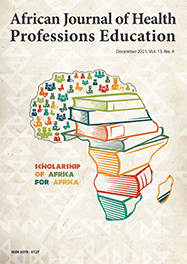Articles

The implementation of the Objective Structured Practical Examination (OSPE) method: Students’ and examiners’ experiences
Abstract
Background. Traditionally, physiotherapy practical skills have been assessed by a method that relies on the subjective interpretation of competency by the examiner and lacks the formative benefits of assessment.
Objective. To describe and compare student performance and satisfaction and examiner satisfaction with regard to the Objective Structured Practical Examination (OSPE) and traditional mark sheets during the practical skills assessment.
Method. Students and examiners taking part in the second-year physiotherapy practical skills test were invited to participate by completing a series of questionnaires. Performance of techniques was marked using both the OSPE and traditional mark sheets.
Results. Sixty-seven students and nine examiners participated in the study. Students scored an average of 4.6% (SD ±16.4) better when using the traditional mark sheet. Nonetheless, students and examiners expressed a preference for the OSPE mark sheet.
Conclusion. The OSPE mark sheet allows for increased objectivity, as the specific micro-skills are clearly listed and appropriately weighted. This resulted in increased satisfaction, but a decrease in marks obtained. By assessing the effect of implementation of the OSPE method on performance and satisfaction, change in the current situation can be monitored.
Authors' affiliations
B Olivier, Department of Physiotherapy, Faculty of Health Sciences, University of the Witwatersrand, Johannesburg, South Africa
V Naidoo, Department of Physiotherapy, Faculty of Health Sciences, University of the Witwatersrand, Johannesburg, South Africa
W Mudzi, Department of Physiotherapy, Faculty of Health Sciences, University of the Witwatersrand, Johannesburg, South Africa
H van Aswegen, Department of Physiotherapy, Faculty of Health Sciences, University of the Witwatersrand, Johannesburg, South Africa
J Potterton, Department of Physiotherapy, Faculty of Health Sciences, University of the Witwatersrand, Johannesburg, South Africa
H Myezwa, Department of Physiotherapy, Faculty of Health Sciences, University of the Witwatersrand, Johannesburg, South Africa
R Roos, Department of Physiotherapy, Faculty of Health Sciences, University of the Witwatersrand, Johannesburg, South Africa
L Godlwana, Department of Physiotherapy, Faculty of Health Sciences, University of the Witwatersrand, Johannesburg, South Africa
D Maleka, Department of Physiotherapy, Faculty of Health Sciences, University of the Witwatersrand, Johannesburg, South Africa
S Mtshali, Department of Physiotherapy, Faculty of Health Sciences, University of the Witwatersrand, Johannesburg, South Africa
V Ntsiea, Department of Physiotherapy, Faculty of Health Sciences, University of the Witwatersrand, Johannesburg, South Africa
A Stewart, Department of Physiotherapy, Faculty of Health Sciences, University of the Witwatersrand, Johannesburg, South Africa
M Romm, Department of Physiotherapy, Faculty of Health Sciences, University of the Witwatersrand, Johannesburg, South Africa
C Humphries, Department of Physiotherapy, Faculty of Health Sciences, University of the Witwatersrand, Johannesburg, South Africa
B Watt, Department of Physiotherapy, Faculty of Health Sciences, University of the Witwatersrand, Johannesburg, South Africa
Full Text
Keywords
Cite this article
Article History
Date published: 2015-02-23
Article Views
Full text views: 3511




.jpg)
Comments on this article
*Read our policy for posting comments here